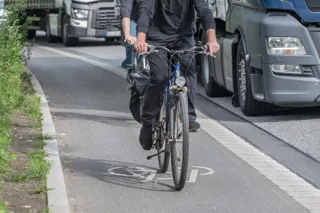Matt de Prez gives insight on how TfL's Safe Urban Driving course has got 20,000 commercial vehicle drivers onto pushbikes and swap eight wheels for two.
No fleet operator wants to receive the call that one of their vehicles has killed or seriously injured a pedestrian or cyclist – yet every year more than 2,000 people are victims of such incidents on the streets of London alone.
In 2011 Transport for London (TfL) launched the Safe Urban Driving training course to try to curb the increasing number of vulnerable road users injured on the city’s streets.
It was created to give drivers a different perspective by travelling on the road as a vulnerable road user, which includes pedestrians, cyclists and motorcyclists.
As part of the training, all drivers must complete a practical cycling element which sees them cycle on public highways, giving drivers a real-life experience as to a cyclist’s perspective of riding around the capital.

Principal provider
Fleet Source is the principal training provider for the programme. The company has delivered the course to more than 20,000 commercial vehicle drivers since it launched four years ago.
Commercial Fleet was invited to attend a session at the training provider’s newly launched Barking Training Centre.
On the day we were joined by drivers from Travis Perkins, one of the developers of the course.
Graham Bellman, fleet director at Travis Perkins, says: “Having this insight into the behaviours of other road users is invaluable in making our communities and streets safer, not only in London but all across the UK.”
To date the building supplier has committed to training 4,000 drivers on the Safe Urban Driving course with Fleet Source, an investment of £750,000.
“We’ve had around 20 free courses funded by TfL. Our commitment to roll this out nationally means there is a cost to us - but it’s investing in our drivers and making people safer,” says Bellman.
“The investment is more than just monetary. It takes time to train those drivers and they need to take a day out of their normal duties.”
He believes there is a return on investment because the business benefits from safer drivers who appreciate the hazards on the road.
Ultimately, this means fewer incidents.
“Travis Perkins wanted to ensure that they got drivers considering how they currently drive and the impact that has on vulnerable road users,” adds Steve Hamon, sales and marketing director at Fleet Source.
He says: “Taking drivers out into the urban environment on a pushbike really enables them to see road safety from a different perspective to what they usually experience behind the wheel in their HGVs.”
Key for compliance
Safer Urban Driving is a requirement of the Fleet Operator Recognition Scheme (FORS) Silver and Construction Logistics and Community Safety (CLOCS). TfL has also included it as part of the Work-Related Road Risks (WRRR) clause in more than 600 new contracts issued across the capital.
Bellman says: “As a FORS Gold-accredited business, it’s a requirement for us to demonstrate that our drivers have completed the course. There is also a desire within the business – construction vehicles seem to be involved in more serious incidents than any other category, therefore it is important for us to provide our drivers with the best education available.”
The seven-hour course qualifies as part of a drivers’ CPC and it is recommended that it is re-visited every five years.
All Travis Perkins drivers are put through the training irrespective of the size of vehicle they operate.
“Getting everyone trained is a bit like painting the Forth Bridge,” says Bellman. “Sometimes there is a shortage of drivers or just a natural churn, so there is always someone to train. Our national programme has been in existence for 18 months but we’ve been doing it in focused areas of London for five years.
“The challenge in London is greater because it’s a condensed area and congestion is worse than anywhere else, but we have approached this as a UK-wide initiative.”
‘It’s surprising how much you panic when you see big trucks coming’
Tony Spendlove has been an HGV driver for 20 years, serving the past 12 at Travis Perkins. He spends most of his time driving in London and says the biggest changes have occurred in the past decade.
“The introduction of the pay-to-ride bikes opened cycling up to lots of new people, including children,” he explains.
“When I joined Travis Perkins all the safety stuff was just coming in. The ethos is very much around safety, not just for drivers but other employees and vulnerable road users too.
“There’s a lot to think about when driving in the city. Cameras, traffic lights and congestion – I can see why a lot of drivers are leaving. It is stressful; there is a lot to think about.”
Spendlove attends two training sessions per year. He says: “I still learn things every time. From little tips and what the new vehicles can do to the new laws that come in. These courses give you the chance to ask questions.
“The first time I did the training I was on a busy main road, it was surprising how much you panic when you see these big trucks coming. It just made me aware of getting the right position on the road and hanging back a bit.”
Having completed the course twice, Spendlove admitted that cyclists are still a bugbear when driving in the city but he now takes a few minutes and adjusts his attitude if he finds it too stressful.
Lessons on the road
After a safety briefing the attendees are taken outside where their cycling abilities are assessed. Once the trainers are satisfied that everyone is capable of handling the bikes, a number of basic exercises are performed.
This ensures the riders are comfortable on the cycles and also allows them to experience how the bike responds in certain scenarios such as swerving or braking.
The riders are then led out onto the streets to experience real-life cycling on the roads.
Travis Perkins’ Graham Bellman says: “The driver population of the UK is in an age profile of 40-50. It’s an ageing population. Even among the young drivers, if you ask them when they were last on a bike they’ll say more than five years ago. With the older ones it might be 20 or 30 years since they rode a bike.
“To put somebody who usually drives a big truck around the UK roads on a push bike is really placing people outside their comfort zone, which has an edge to it. Generally we’ve had great feedback on it.”





















Login to comment
Comments
No comments have been made yet.